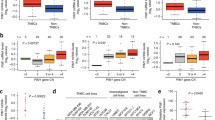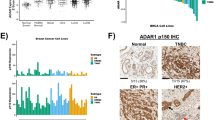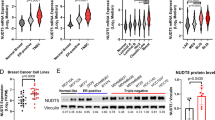Abstract
Triple-negative breast cancer (TNBC) is an aggressive breast cancer subtype with generally poor prognosis and no available targeted therapies, highlighting a critical unmet need to identify and characterize novel therapeutic targets. We previously demonstrated that CIB1 is necessary for cancer cell survival and proliferation via regulation of two oncogenic signaling pathways, RAF–MEK–ERK and PI3K–AKT. Because these pathways are often upregulated in TNBC, we hypothesized that CIB1 may play a broader role in TNBC cell survival and tumor growth. Methods utilized include inducible RNAi depletion of CIB1 in vitro and in vivo, immunoblotting, clonogenic assay, flow cytometry, RNA-sequencing, bioinformatics analysis, and Kaplan–Meier survival analysis. CIB1 depletion resulted in significant cell death in 8 of 11 TNBC cell lines tested. Analysis of components related to PI3K–AKT and RAF–MEK–ERK signaling revealed that elevated AKT activation status and low PTEN expression were key predictors of sensitivity to CIB1 depletion. Furthermore, CIB1 knockdown caused dramatic shrinkage of MDA-MB-468 xenograft tumors in vivo. RNA sequence analysis also showed that CIB1 depletion in TNBC cells activates gene programs associated with decreased proliferation and increased cell death. CIB1 expression levels per se did not predict TNBC susceptibility to CIB1 depletion, and CIB1 mRNA expression levels did not associate with TNBC patient survival. Our data are consistent with the emerging concept of non-oncogene addiction, where a large subset of TNBCs depend on CIB1 for cell survival and tumor growth, independent of CIB1 expression levels. Our data establish CIB1 as a novel therapeutic target for TNBC.




Similar content being viewed by others
References
Siegel R, Ma J, Zou Z, Jemal A (2014) Cancer statistics, 2014. CA Cancer J Clin 64(1):9–29. doi:10.3322/caac.21208
Blows FM, Driver KE, Schmidt MK, Broeks A, van Leeuwen FE, Wesseling J, Cheang MC, Gelmon K, Nielsen TO, Blomqvist C, Heikkila P, Heikkinen T, Nevanlinna H, Akslen LA, Begin LR, Foulkes WD, Couch FJ, Wang X, Cafourek V, Olson JE, Baglietto L, Giles GG, Severi G, McLean CA, Southey MC, Rakha E, Green AR, Ellis IO, Sherman ME, Lissowska J, Anderson WF, Cox A, Cross SS, Reed MW, Provenzano E, Dawson SJ, Dunning AM, Humphreys M, Easton DF, Garcia-Closas M, Caldas C, Pharoah PD, Huntsman D (2010) Subtyping of breast cancer by immunohistochemistry to investigate a relationship between subtype and short and long term survival: a collaborative analysis of data for 10,159 cases from 12 studies. PLoS Med 7(5):e1000279. doi:10.1371/journal.pmed.1000279
Mirzoeva OK, Das D, Heiser LM, Bhattacharya S, Siwak D, Gendelman R, Bayani N, Wang NJ, Neve RM, Guan Y, Hu Z, Knight Z, Feiler HS, Gascard P, Parvin B, Spellman PT, Shokat KM, Wyrobek AJ, Bissell MJ, McCormick F, Kuo WL, Mills GB, Gray JW, Korn WM (2009) Basal subtype and MAPK/ERK kinase (MEK)-phosphoinositide 3-kinase feedback signaling determine susceptibility of breast cancer cells to MEK inhibition. Cancer Res 69(2):565–572. doi:10.1158/0008-5472.CAN-08-3389
Hoeflich KP, O’Brien C, Boyd Z, Cavet G, Guerrero S, Jung K, Januario T, Savage H, Punnoose E, Truong T, Zhou W, Berry L, Murray L, Amler L, Belvin M, Friedman LS, Lackner MR (2009) In vivo antitumor activity of MEK and phosphatidylinositol 3-kinase inhibitors in basal-like breast cancer models. Clin Cancer Res: Off J Am Assoc Cancer Res 15(14):4649–4664. doi:10.1158/1078-0432.CCR-09-0317
Shimizu T, Tolcher AW, Papadopoulos KP, Beeram M, Rasco DW, Smith LS, Gunn S, Smetzer L, Mays TA, Kaiser B, Wick MJ, Alvarez C, Cavazos A, Mangold GL, Patnaik A (2012) The clinical effect of the dual-targeting strategy involving PI3K/AKT/mTOR and RAS/MEK/ERK pathways in patients with advanced cancer. Clin Cancer Res: Off J Am Assoc Cancer Res 18(8):2316–2325. doi:10.1158/1078-0432.CCR-11-2381
De Luca A, Maiello MR, D’Alessio A, Pergameno M, Normanno N (2012) The RAS/RAF/MEK/ERK and the PI3 K/AKT signalling pathways: role in cancer pathogenesis and implications for therapeutic approaches. Exp Opin Ther Targets 16(Suppl 2):S17–S27. doi:10.1517/14728222.2011.639361
Rodon J, Dienstmann R, Serra V, Tabernero J (2013) Development of PI3K inhibitors: lessons learned from early clinical trials. Nat Rev Clin Oncol 10(3):143–153. doi:10.1038/nrclinonc.2013.10
Britten CD (2013) PI3K and MEK inhibitor combinations: examining the evidence in selected tumor types. Cancer Chemother Pharmacol 71(6):1395–1409. doi:10.1007/s00280-013-2121-1
Crown J, O’Shaughnessy J, Gullo G (2012) Emerging targeted therapies in triple-negative breast cancer. Ann Oncol: Off J Eur Soc Med Oncol/ESMO 23(Suppl 6):vi56–vi65. doi:10.1093/annonc/mds196
Leisner TM, Moran C, Holly SP, Parise LV (2013) CIB1 prevents nuclear GAPDH accumulation and non-apoptotic tumor cell death via AKT and ERK signaling. Oncogene 32(34):4017–4027. doi:10.1038/onc.2012.408
Leisner TM, Liu M, Jaffer ZM, Chernoff J, Parise LV (2005) Essential role of CIB1 in regulating PAK1 activation and cell migration. J Cell Biol 170(3):465–476. doi:10.1083/jcb.200502090
Yoon KW, Cho JH, Lee JK, Kang YH, Chae JS, Kim YM, Kim J, Kim EK, Kim SE, Baik JH, Naik UP, Cho SG, Choi EJ (2009) CIB1 functions as a Ca(2+)-sensitive modulator of stress-induced signaling by targeting ASK1. Proc Natl Acad Sci USA 106(41):17389–17394. doi:10.1073/pnas.0812259106
Kauselmann G, Weiler M, Wulff P, Jessberger S, Konietzko U, Scafidi J, Staubli U, Bereiter-Hahn J, Strebhardt K, Kuhl D (1999) The polo-like protein kinases Fnk and Snk associate with a Ca(2+)- and integrin-binding protein and are regulated dynamically with synaptic plasticity. EMBO J 18(20):5528–5539. doi:10.1093/emboj/18.20.5528
Jarman KE, Moretti PA, Zebol JR, Pitson SM (2010) Translocation of sphingosine kinase 1 to the plasma membrane is mediated by calcium- and integrin-binding protein 1. J Biol Chem 285(1):483–492. doi:10.1074/jbc.M109.068395
Freeman TC Jr, Black JL, Bray HG, Dagliyan O, Wu YI, Tripathy A, Dokholyan NV, Leisner TM, Parise LV (2013) Identification of novel integrin binding partners for calcium and integrin binding protein 1 (CIB1): structural and thermodynamic basis of CIB1 promiscuity. Biochemistry 52(40):7082–7090. doi:10.1021/bi400678y
Yuan W, Leisner TM, McFadden AW, Wang Z, Larson MK, Clark S, Boudignon-Proudhon C, Lam SC, Parise LV (2006) CIB1 is an endogenous inhibitor of agonist-induced integrin alphaIIbbeta3 activation. J Cell Biol 172(2):169–175. doi:10.1083/jcb.200505131
Junrong T, Huancheng Z, Feng H, Yi G, Xiaoqin Y, Zhengmao L, Hong Z, Jianying Z, Yin W, Yuanhang H, Jianlin Z, Longhua S, Guolin H (2011) Proteomic identification of CIB1 as a potential diagnostic factor in hepatocellular carcinoma. J Biosci 36(4):659–668
Son SM, Byun J, Roh SE, Kim SJ, Mook-Jung I (2014) Reduced IRE1alpha mediates apoptotic cell death by disrupting calcium homeostasis via the InsP3 receptor. Cell Death Dis 5:e1188. doi:10.1038/cddis.2014.129
Bandyopadhyay C, Valiya-Veettil M, Dutta D, Chakraborty S, Chandran B (2014) CIB1 synergizes with EphrinA2 to regulate Kaposi’s sarcoma-associated herpesvirus macropinocytic entry in human microvascular dermal endothelial cells. PLoS Pathog 10(2):e1003941. doi:10.1371/journal.ppat.1003941
Naik MU, Naik UP (2011) Contra-regulation of calcium- and integrin-binding protein 1-induced cell migration on fibronectin by PAK1 and MAP kinase signaling. J Cell Biochem 112(11):3289–3299. doi:10.1002/jcb.23255
Gordon V, Banerji S (2013) Molecular pathways: PI3K pathway targets in triple-negative breast cancers. Clin Cancer Res: Off J Am Assoc Cancer Res 19(14):3738–3744. doi:10.1158/1078-0432.CCR-12-0274
Prat A, Karginova O, Parker JS, Fan C, He X, Bixby L, Harrell JC, Roman E, Adamo B, Troester M, Perou CM (2013) Characterization of cell lines derived from breast cancers and normal mammary tissues for the study of the intrinsic molecular subtypes. Breast Cancer Res Treat 142(2):237–255. doi:10.1007/s10549-013-2743-3
Prat A, Parker JS, Karginova O, Fan C, Livasy C, Herschkowitz JI, He X, Perou CM (2010) Phenotypic and molecular characterization of the claudin-low intrinsic subtype of breast cancer. Breast Cancer Res: BCR 12(5):R68. doi:10.1186/bcr2635
Zayed MA, Yuan W, Leisner TM, Chalothorn D, McFadden AW, Schaller MD, Hartnett ME, Faber JE, Parise LV (2007) CIB1 regulates endothelial cells and ischemia-induced pathological and adaptive angiogenesis. Circ Res 101(11):1185–1193. doi:10.1161/CIRCRESAHA.107.157586
Yuan W, Leisner TM, McFadden AW, Clark S, Hiller S, Maeda N, O’Brien DA, Parise LV (2006) CIB1 is essential for mouse spermatogenesis. Mol Cell Biol 26(22):8507–8514. doi:10.1128/MCB.01488-06
Brown JM, Attardi LD (2005) The role of apoptosis in cancer development and treatment response. Nat Rev Cancer 5(3):231–237. doi:10.1038/nrc1560
Khadka P, Lee JH, Baek SH, Oh SY, Chung IK (2014) DNA-PKcs-interacting protein KIP binding to TRF2 is required for the maintenance of functional telomeres. Biochem J 463(1):19–30. doi:10.1042/BJ20131395
Pfefferle AD, Spike BT, Wahl GM, Perou CM (2015) Luminal progenitor and fetal mammary stem cell expression features predict breast tumor response to neoadjuvant chemotherapy. Breast Cancer Res Treat. doi:10.1007/s10549-014-3262-6
Taube JH, Herschkowitz JI, Komurov K, Zhou AY, Gupta S, Yang J, Hartwell K, Onder TT, Gupta PB, Evans KW, Hollier BG, Ram PT, Lander ES, Rosen JM, Weinberg RA, Mani SA (2010) Core epithelial-to-mesenchymal transition interactome gene-expression signature is associated with claudin-low and metaplastic breast cancer subtypes. Proc Natl Acad Sci USA 107(35):15449–15454. doi:10.1073/pnas.1004900107
Wirapati P, Sotiriou C, Kunkel S, Farmer P, Pradervand S, Haibe-Kains B, Desmedt C, Ignatiadis M, Sengstag T, Schutz F, Goldstein DR, Piccart M, Delorenzi M (2008) Meta-analysis of gene expression profiles in breast cancer: toward a unified understanding of breast cancer subtyping and prognosis signatures. Breast Cancer Res: BCR 10(4):R65. doi:10.1186/bcr2124
McIlwain CC, Townsend DM, Tew KD (2006) Glutathione S-transferase polymorphisms: cancer incidence and therapy. Oncogene 25(11):1639–1648. doi:10.1038/sj.onc.1209373
Naik MU, Pham NT, Beebe K, Dai W, Naik UP (2011) Calcium-dependent inhibition of polo-like kinase 3 activity by CIB1 in breast cancer cells. Int J Cancer J Int du Cancer 128(3):587–596. doi:10.1002/ijc.25388
Harrell JC, Prat A, Parker JS, Fan C, He X, Carey L, Anders C, Ewend M, Perou CM (2012) Genomic analysis identifies unique signatures predictive of brain, lung, and liver relapse. Breast Cancer Res Treat 132(2):523–535. doi:10.1007/s10549-011-1619-7
Curtis C, Shah SP, Chin SF, Turashvili G, Rueda OM, Dunning MJ, Speed D, Lynch AG, Samarajiwa S, Yuan Y, Graf S, Ha G, Haffari G, Bashashati A, Russell R, McKinney S, Langerod A, Green A, Provenzano E, Wishart G, Pinder S, Watson P, Markowetz F, Murphy L, Ellis I, Purushotham A, Borresen-Dale AL, Brenton JD, Tavare S, Caldas C, Aparicio S (2012) The genomic and transcriptomic architecture of 2,000 breast tumours reveals novel subgroups. Nature 486(7403):346–352. doi:10.1038/nature10983
Hatzis C, Pusztai L, Valero V, Booser DJ, Esserman L, Lluch A, Vidaurre T, Holmes F, Souchon E, Wang H, Martin M, Cotrina J, Gomez H, Hubbard R, Chacon JI, Ferrer-Lozano J, Dyer R, Buxton M, Gong Y, Wu Y, Ibrahim N, Andreopoulou E, Ueno NT, Hunt K, Yang W, Nazario A, DeMichele A, O’Shaughnessy J, Hortobagyi GN, Symmans WF (2011) A genomic predictor of response and survival following taxane-anthracycline chemotherapy for invasive breast cancer. JAMA 305(18):1873–1881. doi:10.1001/jama.2011.593
Saal LH, Gruvberger-Saal SK, Persson C, Lovgren K, Jumppanen M, Staaf J, Jonsson G, Pires MM, Maurer M, Holm K, Koujak S, Subramaniyam S, Vallon-Christersson J, Olsson H, Su T, Memeo L, Ludwig T, Ethier SP, Krogh M, Szabolcs M, Murty VV, Isola J, Hibshoosh H, Parsons R, Borg A (2008) Recurrent gross mutations of the PTEN tumor suppressor gene in breast cancers with deficient DSB repair. Nat Genet 40(1):102–107. doi:10.1038/ng.2007.39
Podsypanina K, Ellenson LH, Nemes A, Gu J, Tamura M, Yamada KM, Cordon-Cardo C, Catoretti G, Fisher PE, Parsons R (1999) Mutation of Pten/Mmac1 in mice causes neoplasia in multiple organ systems. Proc Natl Acad Sci USA 96(4):1563–1568
Luo J, Solimini NL, Elledge SJ (2009) Principles of cancer therapy: oncogene and non-oncogene addiction. Cell 136(5):823–837. doi:10.1016/j.cell.2009.02.024
Solimini NL, Luo J, Elledge SJ (2007) Non-oncogene addiction and the stress phenotype of cancer cells. Cell 130(6):986–988. doi:10.1016/j.cell.2007.09.007
Riabinska A, Daheim M, Herter-Sprie GS, Winkler J, Fritz C, Hallek M, Thomas RK, Kreuzer KA, Frenzel LP, Monfared P, Martins-Boucas J, Chen S, Reinhardt HC (2013) Therapeutic targeting of a robust non-oncogene addiction to PRKDC in ATM-defective tumors. Sci Transl Med 5(189):189ra178. doi:10.1126/scitranslmed.3005814
Love MI, Huber W, Anders S (2014) Moderated estimation of fold change and dispersion for RNA-seq data with DESeq2. Genome Biol 15(12):550. doi:10.1186/s13059-014-0550-8
Acknowledgments
We thank Paul Truex, Dinesh Srinivasan, Thomas Freeman, and Thomas Stewart for helpful discussions. We also thank Charlene Santos and Mark Ross for assistance with mouse xenograft experiments, and Amy Perou for managing RNAseq processing and data collection. This work was supported by NHLBI 1R01HL092544 and NC TraCS 4DR11410 (LV Parise), AHA 13PRE16470024 (JL Black), the Triple Negative Breast Cancer Foundation and NCI Breast SPORE program (P50-CA58223-09A1) (JC Harrell and CM Perou), and NCBC 2013-MRG-1110 (CD Jones).
Conflict of interest
JL Black, TM Leisner, and LV Parise are co-founders of Reveris Therapeutics, LLC. CM Perou is an equity stock holder, consultant, and member of the board of directors of BioClassifier LLC and GeneCentric Diagnostics. The other authors declare no potential conflicts of interest.
Author information
Authors and Affiliations
Corresponding author
Electronic supplementary material
Below is the link to the electronic supplementary material.
10549_2015_3458_MOESM1_ESM.tif
Supplementary Figure S1. CIB1 depletion reduces cell proliferation in a panel of TNBC cell lines. A) A panel of 11 TNBC cells lines were transduced with either control (SCR) or two separate CIB1 shRNA targeting sequences (CIB1 shRNA1 or shRNA2). SCR was normalized to 1.0 (dotted line) and graph represents relative mean fold change in total cell count ± SEM for each CIB1 shRNA treated sample (n ≥ 3). B Average differentiation score of sensitive and insensitive cell lines from TNBC cell line panel. Cell lines sensitive to CIB1 depletion trend toward a lower differentiation score than insensitive cell lines (P = .0695). Supplementary material 1 (TIFF 3402 kb)
10549_2015_3458_MOESM2_ESM.tif
Supplementary Figure S2. Effect of CIB1 depletion on cell death in non-TNBC cell lines. A) A panel of three non-TNBC cell lines were transduced with either control or CIB1 shRNA. Graph represents average percent cell death ± SEM for each sample (n = 3). ZR-75-1 had significantly higher cell death upon CIB1 depletion. B) Relative levels of pAKT, AKT, pERK, ERK, CIB1, and Rac (loading control) in CIB1-depleted and control samples. CIB1 depletion results in reduction in pAKT and pERK in ZR-75-1 cells, corresponding to increased cell death. Supplementary material 2 (TIFF 2213 kb)
10549_2015_3458_MOESM3_ESM.tif
Supplementary Figure S3. CIB1 depletion decreases TNBC cell proliferation and increases cell death in vitro and in vivo. A) CIB1 depletion decreases MDA-468 proliferation and viability. Graphs represent mean total cell number ± SEM (Upper panel) and mean percentage of dead cells ± SEM (Lower panel) at each time point (n = 3). *P < .001; **P < .01. B) Measurement of cell surface phosphatidylserine (Annexin V binding) and cell permeability to 7-AAD. A higher percentage of MDA-468-CIB1shRNA+Dox cells are positive for both Annexin V and 7-AAD, indicating a higher percentage of dead cells. C-D) Relative levels of pAKT, AKT, pERK, ERK, CIB1, γH2AX, and Rac (loading control) in CIB1-depleted and control samples in vitro (C) and in vivo (D). MDA-468-CIB1shRNA+Dox exhibit complete depletion of CIB1, and decreased pERK and pAKT in vitro (C) and in vivo (D), and increased γH2Ax in vitro (C). E) Representative TUNEL-stained xenograft tumor sections show that more of cells from CIB1-depleted tumors are dead or dying (dark brown punctate dots) compared to control tumors. Supplementary material 3 (TIFF 3848 kb)
10549_2015_3458_MOESM4_ESM.tif
Supplementary Figure S4. Expression of constitutively active PAK1 partially rescues CIB1 depletion-induced cell death. A) caPAK1 was overexpressed in MDA-468 cells, followed by treatment with either control or CIB1 shRNA. caPAK1 expression partially rescued cells from CIB1-depletion induced cell death. Graph represents average percent dead cells ± SEM (n = 2). B) Relative levels of PAK1, pAKT, AKT, pERK, ERK, CIB1, and GAPDH (loading control) in control or CIB1 shRNA treated cells ± caPAK1 overexpression. Supplementary material 4 (TIFF 2345 kb)
10549_2015_3458_MOESM5_ESM.tif
Supplementary Figure S5. CIB1 expression is not prognostic for TNBC patient survival. A) CIB1 expression in a population of human ER- tumors does not correlate with probability of relapse-free survival by Kaplan–Meyer survival analysis (n = 256). B) Same as in (A) but focusing on subset of TNBC within the ER- tumors (n = 110). Supplementary material 5 (TIFF 2288 kb)
Rights and permissions
About this article
Cite this article
Black, J.L., Harrell, J.C., Leisner, T.M. et al. CIB1 depletion impairs cell survival and tumor growth in triple-negative breast cancer. Breast Cancer Res Treat 152, 337–346 (2015). https://doi.org/10.1007/s10549-015-3458-4
Received:
Accepted:
Published:
Issue Date:
DOI: https://doi.org/10.1007/s10549-015-3458-4




